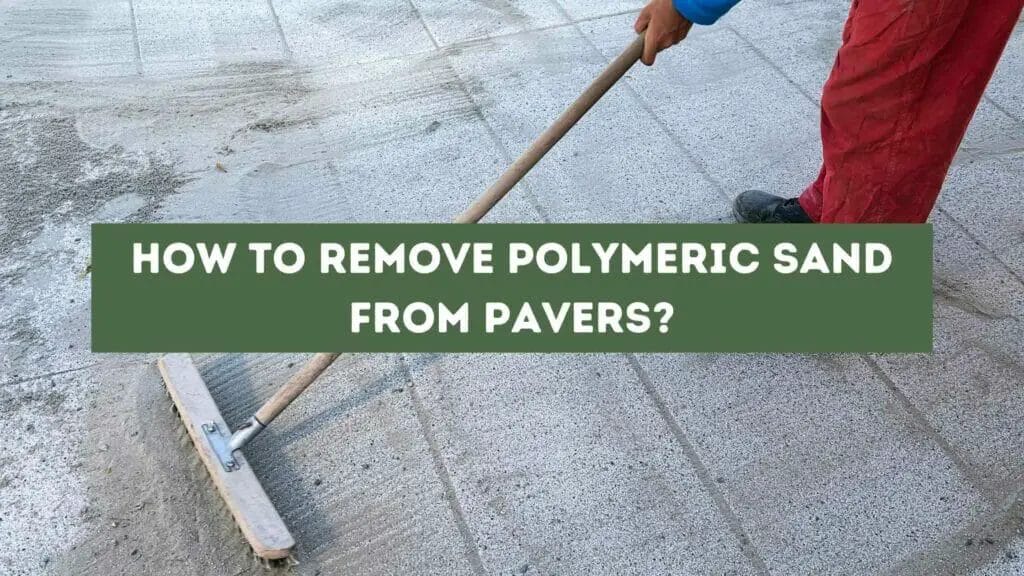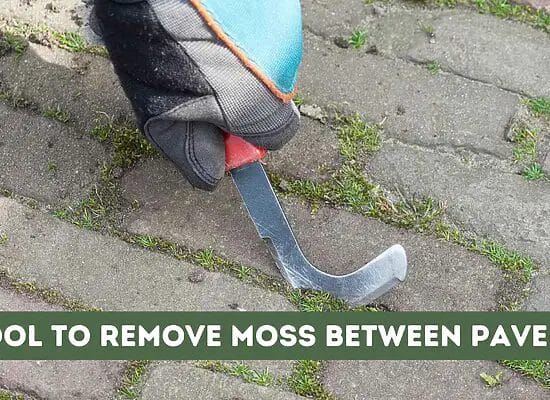
Are you struggling to remove polymeric sand from your pavers without causing any damage? Don’t worry; you’re not alone. Polymeric sand is a popular choice for filling the gaps between pavers, but it can be challenging to remove once it has hardened. Fortunately, there are several methods you can use to remove polymeric sand from your pavers without damaging them.
One of the easiest ways to remove polymeric sand from pavers is by using a broom with soft bristles. Sweep the surface gently to avoid scratching or damaging the pavers. If the polymeric sand has not yet hardened, this method can be very effective.
However, if the sand has hardened, you may need to use a more aggressive method, such as using a leaf blower or steam pressure washing. Keep reading to learn more about how to remove polymeric sand from pavers.
Key takeaways:
- Polymeric sand can cause damage to pavers if not properly removed.
- Removing polymeric sand prevents discoloration, staining, and uneven shifting of pavers.
- Prepare for removal by checking the weather forecast and gathering necessary equipment.
- Wetting the pavers before removal helps loosen the sand.
- Use a broom with soft bristles to sweep the surface and a leaf blower for hard-to-reach areas.
- Step-by-step removal process includes sweeping, removing excess sand, washing out the sand, and using hot water or vinegar solution if necessary.
- Post-removal cleanup involves sweeping, rinsing, ensuring proper drainage, and applying a sealer for protection.
- Avoid common mistakes such as overfilling or under-watering the sand and follow tips and alternative cleaning solutions if needed.
Why Remove Polymeric Sand from Pavers
If you have recently installed pavers, you may have noticed a hazy residue on the surface. This is known as polymeric sand haze, which occurs when there is leftover material on the paver surface. Polymeric sand is a mixture of sand and a special polymer that hardens when exposed to water. It is used to fill the gaps between pavers, preventing weed growth and insect infestation. However, if not removed properly, polymeric sand residue can cause damage to your pavers.
One of the main reasons to remove polymeric sand from pavers is to prevent damage. Polymeric sand haze can cause discoloration and staining on the surface of your pavers. Additionally, if the polymeric sand is not hardening properly, it can cause the pavers to shift and become uneven. This can lead to tripping hazards and other safety concerns.
Another reason to remove polymeric sand from pavers is to prevent weed growth. If the sand is not properly removed, it can create a bed for weeds to grow. Over time, this can cause the pavers to shift and become uneven, leading to more damage.
Over-watering or under-watering can also cause polymeric sand to fail. If the sand is not removed, it can cause the pavers to shift and become uneven, leading to more damage. Removing the polymeric sand can help prevent this from happening.
Preparation Before Removal
Before you start removing polymeric sand from your pavers, it’s important to prepare and gather the necessary equipment. Taking the time to prepare beforehand will save you time and make the process easier.
First, check the weather forecast. You’ll want to choose a day that is dry and sunny, with no chance of rain. Wet conditions can make the sand stickier and harder to remove, and rain can wash away the sand you’re trying to remove.
Next, gather your equipment. You’ll need a water hose or garden hose, a broom with soft bristles, and a leaf blower (optional). If the sand has hardened, you may need a pressure washer or steam and pressure washer to remove it. Make sure you have protective gear, such as gloves and goggles, if you’re using a pressure washer.
Before you start, wet the pavers with a water hose or garden hose. This will help loosen the sand and make it easier to remove. If the sand has hardened, you may need to use a high-pressure water stream to break it up.
Once the pavers are wet, use a broom with soft bristles to sweep the sand off the surface. Be careful not to scratch or damage the pavers. Repeat this step as many times as necessary to remove as much sand as possible. Sweeping the surface will also help to deposit the material into paver joints, making the most of every inch.
If you have a leaf blower, you can use it to blow away any remaining sand. This can be especially helpful for hard-to-reach areas or corners.
Step-by-Step Guide to Removing Polymeric Sand
Removing polymeric sand from pavers can be a challenging task, especially if the sand has hardened or overfilled the gaps between the paver joints. However, with the right tools and techniques, you can restore your pavers to their original beauty. Here is a step-by-step guide to help you remove polymeric sand from your pavers.
- Sweep the Surface: Start by sweeping the surface of the pavers with a soft bristle broom. This will remove any loose sand and debris from the surface, making it easier to access the gaps between the paver joints.
- Remove Excess Sand: Use a leaf blower to remove any excess sand that may have accumulated on the surface or in the gaps between the paver joints. Be careful not to blow out any sand that may be needed to fill the gaps.
- Washout the Sand: Use a garden hose to washout the sand from the gaps between the paver joints. Use a pressure washer if necessary, but be careful not to damage the pavers.
- Use Hot Water: If the sand is stubborn, you can use hot water to soften it. Boil some water and pour it over the sand. Let it sit for a few minutes, and then use a pressure washer to wash it out.
- White Vinegar Solution: If the sand still remains, you can use a white vinegar and water solution to dissolve it. Mix equal parts of white vinegar and water and pour it over the sand. Let it sit for a few minutes, and then use a pressure washer to wash it out.
- Remove Polymeric Sand Haze: If there is a haze left on the surface of the pavers, you can use a solution of white vinegar and water to remove it. Mix equal parts of white vinegar and water and apply it to the surface of the pavers. Let it sit for a few minutes, and then scrub it with a soft bristle brush. Rinse with water.
- Resand the Gaps: Once the sand has been removed, you can resand the gaps between the paver joints with joint sand. Be careful not to overfill the gaps, as this can cause drainage and moisture problems.
Attention: It is important to keep the pavers dry during the removal process. Mist the pavers with water before removing the sand to prevent it from hardening and separating the pavers.
Post-Removal Cleanup and Maintenance
Now that you have successfully removed the polymeric sand from your pavers, it’s time to focus on the post-removal cleanup and maintenance. Proper maintenance will ensure that your pavers remain in good condition for a longer period of time.
One of the first things you should do is to sweep the surface of the pavers with a broom with soft bristles. This will help to remove any remaining sand and debris. You can also use a garden hose to rinse the surface of the pavers. However, be careful not to use too much pressure as this can damage the pavers.
If you have a driveway or patio with poor drainage, it’s important to ensure that the slope is correct. This will help to prevent water from pooling on the surface of the pavers, which can lead to the growth of algae and moss. If you notice poor drainage, you may need to add more base material, such as concrete sand or stone dust.
After cleaning the surface of the pavers, it’s important to apply a sealer to protect them from the elements. A sealer will help to prevent water from seeping into the pavers, which can cause them to crack or chip over time. Be sure to follow the manufacturer’s instructions when applying the sealer.
In addition to regular maintenance, there are a few pro tips that can help to keep your pavers in good condition. For example, avoid using harsh chemicals or abrasive cleaners on the surface of the pavers, as this can scratch or damage them. Instead, use a mild detergent and warm water to clean the surface.
Pro Tip: Another pro tip is to avoid using a pressure washer on the pavers unless absolutely necessary. While a pressure washer can be effective at removing stubborn stains, it can also damage the surface of the pavers if used incorrectly.
Replacing the Sand in Paver Joints
If you notice that the polymeric sand has become too hard, or if you need to remove weeds that have grown in the joints, you may need to replace the sand in your paver joints. Here’s how to do it:
- Remove the old sand. Use a broom or leaf blower to remove any loose sand from the paver joints. Then, use a scraper or chisel to remove any hardened or crusty sand. Be careful not to damage the pavers or the joint edges.
- Clean the joints. Use a hose or pressure washer to clean the joints thoroughly. Make sure there is no debris or dust left in the joints. Let the joints dry completely before proceeding.
- Choose the right sand. Regular jointing sand can be used to replace the polymeric sand. Make sure to choose a sand that is compatible with your pavers. The sand should be clean, dry, and free of any contaminants.
- Fill the joints. Pour the sand into the joints, making sure to fill them completely. Use a broom to sweep the sand into the joints and compact it. Add more sand if necessary to make sure the joints are completely filled.
- Compact the sand. Use a plate compactor or hand tamper to compact the sand into the joints. This will help to prevent settling and keep the sand in place.
- Sweep and clean. Use a broom to sweep any excess sand from the surface of the pavers. Then, use a hose or pressure washer to clean the surface of the pavers. Let the pavers dry completely before walking or driving on them.
Replacing the sand in your paver joints has several advantages. It can help to prevent weeds from growing in the joints, improve the stability of the pavers, and make the surface of the pavers smoother and more even.
When choosing sand for your paver joints, make sure to avoid using sand that contains crystalline silica. This compound can be harmful to your health if inhaled. Instead, choose a sand that is made from quartz or other safe materials.
Common Mistakes to Avoid and Tips
When removing polymeric sand from pavers, there are some common mistakes that homeowners often make. By avoiding these mistakes and following some tips and tricks, you can ensure that the process goes smoothly and that your pavers are not damaged in the process.
Mistakes to Avoid
One of the most common mistakes when removing polymeric sand from pavers is overfilling the joints. Overfilling can lead to the sand hardening on top of the pavers, making it more difficult to remove. Another mistake to avoid is under-watering the sand. If the sand is not properly watered, it will not harden properly and may even wash away.
On the other hand, over-watering can also be a problem. Too much water can cause the sand to wash out of the joints, leaving gaps that can cause the pavers to shift or become uneven. It’s important to follow the manufacturer’s instructions carefully when watering the sand.
Tips and Tricks
To avoid these mistakes, here are some tips and tricks to keep in mind:
- Use a broom with soft bristles to sweep the surface of the pavers, making sure not to scratch or damage them.
- If the sand has not yet hardened, use a leaf blower to remove it from the surface of the pavers.
- Wet the pavers and joints before installing the sand to ensure it is spread evenly and does not activate too quickly.
- Use a brick or block cleaner to remove any hardened sand haze from the surface of the pavers.
- Follow the manufacturer’s instructions carefully when applying and watering the sand.
By following these tips and avoiding common mistakes, you can successfully remove polymeric sand from your pavers without damaging them.
Alternative Cleaning Solutions
If you’re looking for alternative cleaning solutions to remove polymeric sand from your pavers, there are a few options available to you. One of the most effective methods is to use a brick or block paver cleaner. This type of cleaner is specially designed to remove stains and debris from bricks and pavers and typically contains hydrochloric acid as its base. To use this type of cleaner, simply follow the instructions on the label and apply it to the affected area. Be sure to wear protective gear, such as gloves and goggles, when handling this type of cleaner.
Another option for removing polymeric sand from your pavers is to use a brick cleaner. Brick cleaners are designed to dissolve and remove mortar, cement, and other types of stains from brick surfaces. To use a brick cleaner, mix it with water according to the instructions on the label, and apply it to the affected area. Allow the cleaner to sit for a few minutes, then scrub the area with a stiff-bristled brush. Rinse the area thoroughly with water.
If you prefer a more natural cleaning solution, you can try using white vinegar. Vinegar is a natural acid that can help dissolve and remove polymeric sand from your pavers. To use vinegar, mix it with water in a 1:1 ratio, and apply it to the affected area. Allow the solution to sit for a few minutes, then scrub the area with a stiff-bristled brush. Rinse the area thoroughly with water.
Another alternative cleaning solution is to use boiling water. Boiling water can help loosen and dissolve the polymeric sand, making it easier to remove. To use boiling water, simply pour it over the affected area and allow it to sit for a few minutes. Then, use a stiff-bristled brush to scrub the area and rinse it thoroughly with water.
No matter which alternative cleaning solution you choose, be sure to test it on a small, inconspicuous area of your pavers first to ensure that it doesn’t cause any damage. Additionally, be sure to wear protective gear, such as gloves and goggles, when handling any type of cleaner or boiling water.
FAQ: Remove Polymeric Sand from Pavers
What tool removes polymeric sand?
The best tool to remove polymeric sand from pavers is a broom with soft bristles. It is important to avoid using a tool that can scratch or damage the surface of the pavers. If you need to remove hardened polymeric sand, a leaf blower can be used to blow away the sand without damaging the pavers.
How do you remove paver sand from top of pavers?
To remove paver sand from the top of pavers, you can use a broom with soft bristles to sweep the surface. This will help to deposit the sand into the paver joints, making the most of every inch. Repeat this process as many times as necessary to remove as much sand as possible.
How do you remove polymeric haze from pavers?
To remove polymeric haze from pavers, you can use a solution of white vinegar and water. Mix one part vinegar with ten parts water and apply it to the affected area. Let it sit for 10-15 minutes, then scrub with a soft-bristled brush and rinse with water. This should remove the haze without damaging the pavers.
Can you pressure wash polymeric sand?
It is not recommended to pressure wash polymeric sand. The high pressure can damage the pavers and cause the sand to wash away. Instead, use a broom with soft bristles to sweep the surface and remove any debris.
How to clean polymeric sand?
To clean polymeric sand, you can use a solution of water and dish soap. Mix one tablespoon of dish soap with one gallon of water and apply it to the surface. Scrub with a soft-bristled brush and rinse with water. This should remove any dirt or debris without damaging the pavers.












